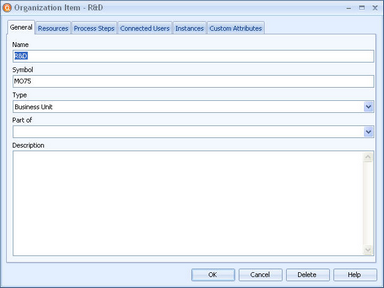Organization Item Dialog |

|

|

|
||
Organization Item Dialog |

|

|

|

|
|
|
||
The Organization Item dialog is used to show properties of one organization item and its connections to other model elements. The Organization Item dialog can be accessed from the Diagram view and the Navigator view by right-clicking the desired note and selecting Organization Item Properties... from the pop-up menu. Also, the Organization Item dialog can be opened from the Process Step dialog or Resource dialog.
The organization item dialog has the following pages: General, Resources, Process Steps, Connected Users (![]()
![]() only), and Custom Attributes (when the organization item contains custom attributes).
only), and Custom Attributes (when the organization item contains custom attributes).
![]()
![]() In the case multilingual modeling has been enabled, click the
In the case multilingual modeling has been enabled, click the ![]() button to open the Translation dialog for adding translations for different languages. You can translate items which are inputted into the model, i.e. items such as element names, flow names, resource names, etc. The
button to open the Translation dialog for adding translations for different languages. You can translate items which are inputted into the model, i.e. items such as element names, flow names, resource names, etc. The ![]() button opens the translation dialog with the translatable strings of the current tab included. Note that the fields display the values of the currently selected modeling language, i.e. in the case translation has not been provided for the active modeling language, the fields are empty.
button opens the translation dialog with the translatable strings of the current tab included. Note that the fields display the values of the currently selected modeling language, i.e. in the case translation has not been provided for the active modeling language, the fields are empty.
General
The General page shows name, symbol, type, part of organization item and the description of the organization item. All these properties can be modified. The symbol is a unique identifier for the organization item. When a new organization item is created, QPR Modeling Client will assign it a unique symbol by getting the model object id and adding "MO" to its beginning. It is also possible to edit the symbol. Allowed characters in the symbol field are alphanumeric characters in upper case and lower case.
![]()
![]() Note that you can use also HTML formatting in the description, but the formatting is visible only in QPR Portal.
Note that you can use also HTML formatting in the description, but the formatting is visible only in QPR Portal.
Resources
On the Resources page all the resources that belong to this organization item are shown. Resources cannot be modified on this page.
Process Steps
On the Process steps page all the process steps which are done in this organization item are shown. Process steps cannot be modified on this page.
![]()
![]()
Connected Users
When connected to the Server, the Connected Users page will also appear in this dialog. From this page users can be added to and removed from the current organization item. When a user is added to the organization item, then that user is connected to the organization item and therefore has it listed on his/her "My Responsibilities" page of the QPR Portal.
Instances
The Instances page lists all the diagrams (in alphabetical order) in which an instance of the current organization item exists. To open the selected diagram and view the instance, click View. To delete the instance from the selected diagram, click Delete.
Custom Attributes
In the Custom Attributes tab, you can manage the values of custom attributes and view the descriptions of selected attributes. This tab is visible only if custom attributes have been defined for organization items. To define a value for the listed attribute, you can just type in the value directly to the field. The values for Boolean and enumerated attributes are selected from a drop-down list. You can also add new values for the attribute by selecting Add if the custom attribute is allowed to have several values (the attribute has cardinality N).
You can use the Remove button to remove individual values from attributes that have cardinality N. The button is enabled only when an attribute with cardinality N is selected in the list.
To clear the value of the selected attribute, select the Clear button. If the value is an attribute set, the action clears all sub-values of the attribute set. If the attribute is an attribute with cardinality N, it removes all values from that attribute.
You can click the View button to open the element properties dialog of the selected element. The button is enabled only for relation type custom attributes that have the relation defined.
For memo and relation attributes, you can use the Modify button to edit the values. Then a new window is opened where you can edit the values, or in the case of a relation attribute, Select Model Elements for Relation is opened for selecting the model element.

Organization Item dialog
Click the OK button to commit any changes you have made or click Cancel to close the window and abandon any possible changes. Click the Delete button to delete the organization item. A confirmation is asked before the organization item is deleted. Click the Help button to open the User's Guide.